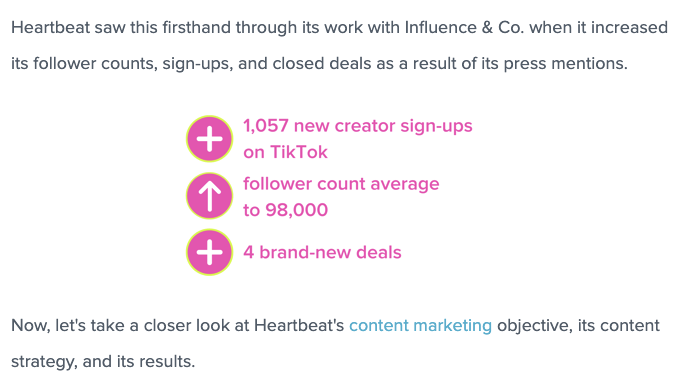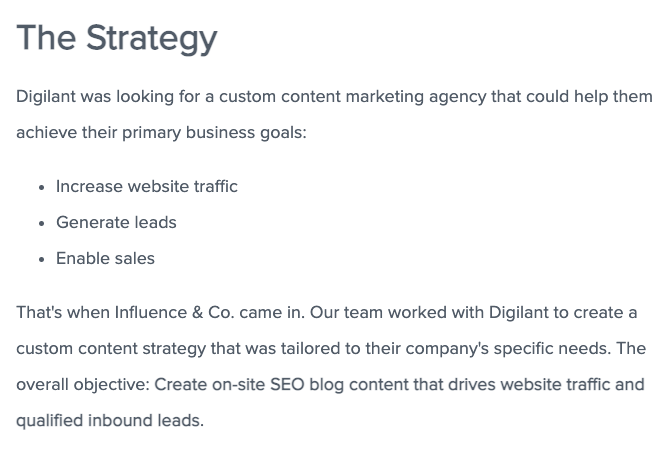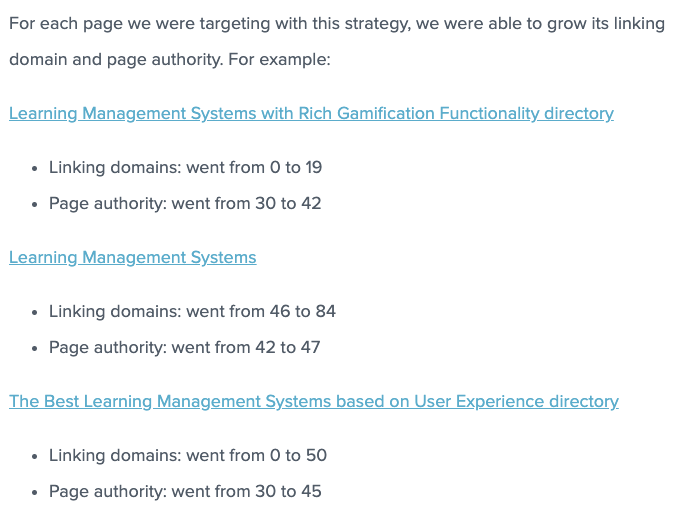
How to Write an Effective Case Study That Closes Sales
How to Write an Effective Case Study That Closes Sales
Alyssa Patzius, VP of Sales • Intero Digital • April 19, 2023

The Quick Version
- Target Audience: Create varied case studies to appeal to different prospective clients.
- Storytelling: Use a narrative structure with a problem, solution, and impressive results.
- Skimmability: Make content easy to skim using bullet points, headers, and visuals.
- Real Data: Include specific numeric insights to demonstrate value.
- Accessibility: Ensure case studies are easy to find on your website.
Part of any marketer’s responsibilities is providing salespeople with thoughtful, well-written digital assets that help overcome sales objections and seal deals. Among the most useful of those assets are case studies. Yet, far too many case studies fall short of their potential.
This isn’t just my opinion. The 2023 “B2B Content Marketing” report released by Content Marketing Institute, MarketingProfs, and ON24 points to a major problem with content marketing case studies. Although 67% of marketers say they created case studies in the past year, just 36% say those case studies produced the best results. So, where’s the disconnect?
The answer: Many content marketers are not following best practices when it comes to crafting compelling content marketing case studies.
Remember: Case studies represent deep dives into how a client used your products, services, and talents to achieve results. The most relevant case studies include quite a bit of pertinent data points to serve as objective indicators that, yes, you’re as good as you say you are. They’re real-life examples that help build trust between your company and leads.
Having content marketing case studies can be a boon to salespeople because they arm them with undeniable proof that others have put their faith in your company — and were awarded with excellent outcomes. Sales teams that can confidently say, “I have something to show you.” have a better chance at converting leads into paying customers.
Case studies serve another purpose too: They make the sales process more engaging. Demos, sales calls, and Zoom meetings can be wildly monotonous and boring if you let them. Case studies add sizzle and memorability to the experience. (And this sets your salespeople apart — in a good way.)
How to Create a Case Study
Unfortunately, many marketing teams just aren’t sure how to write an effective case study from beginning to end. If this describes your position, try the following strategies to pull together your next batch of case studies.
1. Identify which types of prospective clients you want to appeal to.
Ideally, your case studies should be varied. They shouldn’t just target one type of client (unless you’re only interested in one type of client, that is). Instead, mix up your case studies by industry, client size, pain point, innovative solution, etc. That way, your sales team can pick and choose the right case study for each lead.
To determine which case studies you need at the moment, ask sales whether they’re trying to land clients from a certain sector or whether your company is attempting to sell a specific product or service because of its attractive profit margins. Collaborating with sales to determine these answers will guide you toward which existing clients’ successful use cases might be most appropriate for a new case study.
2. Tell a story.
From a bird’s-eye view, your case study should follow a rather staid pattern. You’ll name a client problem, talk about the client’s goal, talk about your solution and strategy, and outline the (impressive!) results. Nevertheless, you don’t have to be dull in your delivery. Find ways to spice up the case study so it reads more like an interesting narrative and less like an academic paper.
For example, when our marketing experts wanted to talk about the way we helped our client Heartbeat achieve results through press mentions, we wanted to draw readers in right away. That’s why we flipped the script and gave readers a snapshot of the happy ending as part of the introduction. Essentially, we used a creative storytelling technique to set up the Heartbeat case study a bit differently than a more traditional chronological approach.

We still used the rest of the case study to break down the objectives, discuss our strategic decision-making, and go over the numbers in greater detail. The main change we made wasn’t the “meat” but the way the meat was dished out.
3. Don’t overlook ‘skimmability.’
Skimmability. It’s become a significant part of everyday life. We all skim everything we read, including pillar pages, news articles, and more. Consequently, don’t assume leads will read your case study from top to bottom. I’m sure 99.99% of them won’t.
The point is that no matter how impressive your case study results might be, you can’t afford to bury them. Utilize skimmable formats such as bullet points, callout boxes, headers, graphics, bold text, colors, and other eye-catching (but not distracting) visuals like we have in our client case study for FitOn. Nix the notion of writing case studies that are just walls of text. They won’t get read, and that means they won’t be much help to your sales team members.

In our case study for our client Digilant, we took care to break up the information on and around the page. We wanted to make sure it was simple to understand and digest. As a side note, we still stuck with solid keyword, context, and tagging rules to get as much SEO juice as we could from the page. (Yes, it’s fine if your case studies do double duty!)

4. Give away the actual numbers.
You might be hesitant to shine a light on what you feel is proprietary data. But avoid giving in to that instinct when it comes to your case studies. Each case study must use real numeric insights. Otherwise, it will just read as a generalization; it will seem more like an advertisement and less like an educational asset.
The only way to illustrate your value in a case study is with real data. You don’t have to reveal all the data, such as how much revenue you made or what your client agreement looked like. Nonetheless, do showcase all the numbers that make your company’s positive impact irrefutable.
For our case study about our client eLearning Industry, we drilled down. Sure, we could have said, “We increased page authority by 12 positions.” Instead, we went into the weeds and gave a better indicator of where eLearning Industry started with its page authority and where it ended up, which offers a much clearer picture for our prospective clients.

5. Make your case studies easy to find.
Too many content marketing case studies are tough to uncover. Assume that not everyone who’s a lead has spoken to your salespeople. Maybe they’re just poking around your website. You want to have a dedicated place where you house your case studies. Ours are under a “Results” tab in our website’s main navigation. However, yours might make sense somewhere else.

Case in point, you could house case studies as individual pages or as hashtagged, searchable blog posts. Many companies are experimenting with video case studies. In that circumstance, you might want to set up your case studies on a YouTube channel and embed them into your website. The options for ensuring your case studies stay front and center are endless. Just make sure you choose an organizational approach that’s intuitive.
Now it’s your turn. Go build (or rebuild) your strongest case studies with an eye toward these best practices. Changing up your efforts can seriously boost your company’s sales — and your salespeople will appreciate having truly helpful assets to aid the sales process.
